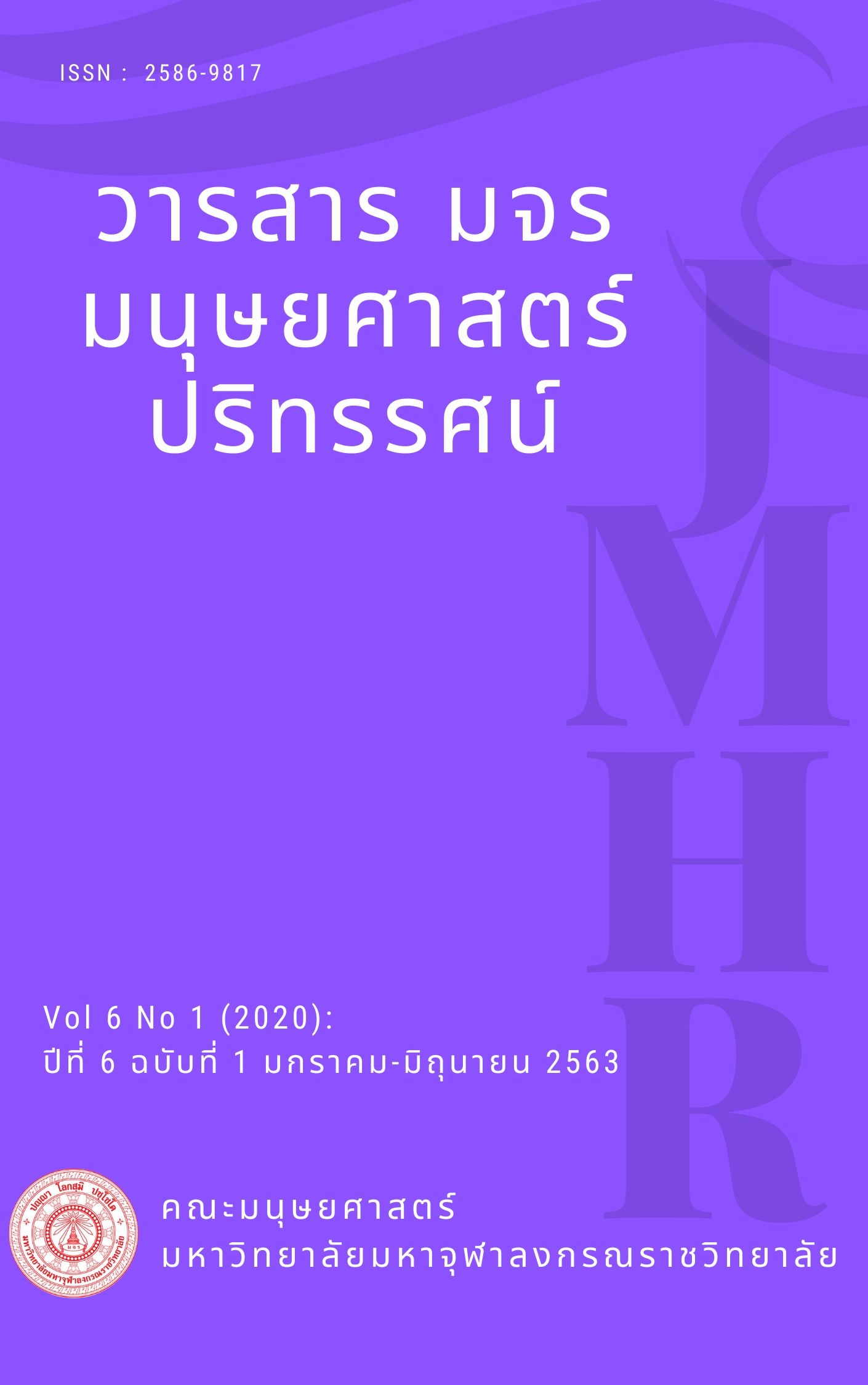การศึกษาภาษาถิ่นบ้านหนองเนิน ตำบลหัวถนน อำเภอท่าตะโก จังหวัดนครสวรรค์
คำสำคัญ:
ภาษาถิ่น, บ้านหนองเนิน, อำเภอท่าตะโก, จังหวัดนครสวรรค์บทคัดย่อ
บทความวิจัยนี้ มีวัตถุประสงค์ เพื่อศึกษาคำพื้นฐานของภาษาถิ่นที่ใช้ในชีวิตประจำวัน และศึกษาคำศัพท์ที่สะท้อนวิถีชีวิตของบ้านหนองเนิน ตำบลหัวถนน อำเภอท่าตะโก จังหวัดนครสวรรค์ โดยผู้วิจัยได้สัมภาษณ์ผู้บอกภาษาและนำข้อมูลมาวิเคราะห์ตามหลักเกณฑ์จากเอกสาร
ผลการวิจัยพบว่า ภาษาถิ่นบ้านหนองเนิน ตำบลหัวถนน อำเภอท่าตะโก จังหวัดนครสวรรค์ เมื่อนำมาเปรียบเทียบกับภาษาไทยมาตรฐานมีลักษณะ 3 ประการ 1) ลักษณะคำที่แตกต่างกันทุกประการเป็นคำศัพท์เฉพาะของชุมชน 2) ลักษณะของคำที่คล้ายกันบางประการเป็นลักษณะคำที่คล้ายกันแต่พบว่ามีการตัดพยางค์ในคำให้สั้นลง 3) ลักษณะคำที่คล้ายกันทุกประการเนื่องจากปัจจุบันใช้ภาษาไทยมาตรฐานในการสื่อสารมากกว่าภาษาถิ่น คำศัพท์ภาษาถิ่นบ้านหนองเนินแสดงให้เห็นการถ่ายทอดวัฒนธรรมใน 5 ลักษณะ 1) วัฒนธรรมเรื่องอาหารที่อยู่อาศัย 2) วัฒนธรรมเรื่องวิถีชีวิต 3) วัฒนธรรมเรื่องพิธีกรรมทางศาสนา 4) วัฒนธรรมเรื่องศิลปะและการละเล่นพื้นบ้าน 5) วัฒนธรรมเรื่องสำเนียงภาษาพูด ดังนั้น จากการศึกษาคำศัพท์ภาษาถิ่นบ้านหนองเนินสะท้อนถึงวัฒนธรรม โดยพบว่า คำศัพท์มีความหลากหลาย เพราะบ้านหนองเนิน มีความหลากหลายทางเชื้อชาติและภูมิศาสตร์
เอกสารอ้างอิง
กรรณิการ์ วิมลเกษม. (2555). ภาษาไทยถิ่นเหนือ (พิมพ์ครั้งที่ 3). กรุงเทพฯ: ภาควิชาภาษาตะวันออก คณะโบราณคดี มหาวิทยาลัยศิลปากร.
ถาวร สุบงกช. (2526). ภาษาถิ่น การวิเคราะห์เรื่องเสียงและความหมาย. นครราชสีมา: ศูนย์วัฒนธรรมจังหวัดนครราชสีมา วิทยาลัยครูนครราชสีมา.
ปรียานุช คำสนอง. (2560). “พลวัตพื้นที่ทางวัฒนธรรมของชุมชนกลุ่มชาติพันธุ์ไทดำในจังหวัดนครสวรรค์”. วารสาร มทร.อีสาน, 4(2), 77-90.
พระยาอนุมานราชธน. (2515). วัฒนธรรมเบื้องต้น. กรุงเทพฯ: ไทยมิตรการพิมพ์.
ไพฑูรย์ ทองทรัพย์. (2552). “การพัฒนาเครือข่ายบ้าน วัดและโรงเรียนในการพัฒนาจริยธรรมเด็กและเยาวชน: กรณีศึกษา หมู่บ้านหัวถนนใต้ ตำบลหัวถนน อำเภอท่าตะโก จังหวัดนครสวรรค์”. วารสารวิชาการ มหาวิทยาลัยราชภัฏอุตรดิตถ์, 4(10), 53-62.
เรืองเดช ปันเขื่อนขัติย์. (2531). ภาษาถิ่น. นครปฐม: สถาบันวิจัยภาษาและวัฒนธรรมเอเชีย มหาวิทยาลัยมหิดล.
วรภพ วงค์รอด. (2559). “การพัฒนาแนวทางการจัดการท่องเที่ยวเชิงวัฒนธรรม: ศึกษากรณีชุมชนวัฒนธรรมไททรง ดำบ้านหนองเนิน อำเภอท่าตะโก จังหวัดนครสวรรค์”, วารสารสังคมศาสตร์วิชาการ, 9(2), 26-44.
สุนทร วรหาร. (2561). “การศึกษาวิจัยเรื่องบทสวดในพิธีศพของชาติพันธุ์ไทดำในประเทศไทย: ความเชื่อ ประเพณี พิธีกรรม และการสื่อความหมาย”. วารสารมนุษยศาสตร์และสังคมศาสตร์ มหาวิทยาลัยราชภัฏอุบลราชธานี, 9(1), 9-19.
สุพิดา เกิดอู่ม. (2561). “สำเนียงภาษาไทยโซ่ง จังหวัดเพชรบุรี”. วารสารวจนะ, 6(1), 1-20.
โสภิตา ถาวร. (2556). การแปรและการเปลี่ยนแปลงเสียงในภาษาไทดำ. นครปฐม: มหาวิทยาลัยมหิดล.
อมรา ประสิทธิ์รัฐสินธุ์. (2549). กว่าจะมาเป็นนักภาษาศาสตร์. กรุงเทพ: ภาควิชาภาษาศาสตร์ คณะอักษรศาสตร์ จุฬาลงกรณ์มหาวิทยาลัย.
อรรถสิทธิ์ บุญสวัสดิ์ และสมทรง บุรุษพัฒน์. (2561). “การแปรของคำเรียกญาติพื้นฐานภาษาไทดำในประเทศไทย ลาวและเวียดนาม”. มนุษยศาสตร์และสังคมศาสตร์, 35(1), 21-42.
อำนาจ เอี่ยมสำอางค์, อำนาจ เย็นสบาย, สาธิต ทิมวัฒนบรรเทิง และ จารุวรรณ ขำเพชร. (2561). “พลวัตทางสังคมกับการดำรงอยู่ของวัฒนธรรมอาหารไทดำในจังหวัดเพชรบุรี”. วารสารมหาจุฬาวิชาการ, 5(ฉบับพิเศษ เนื่องในงานพิธีประทานปริญญาบัตร ปี 2561), 237-249.






